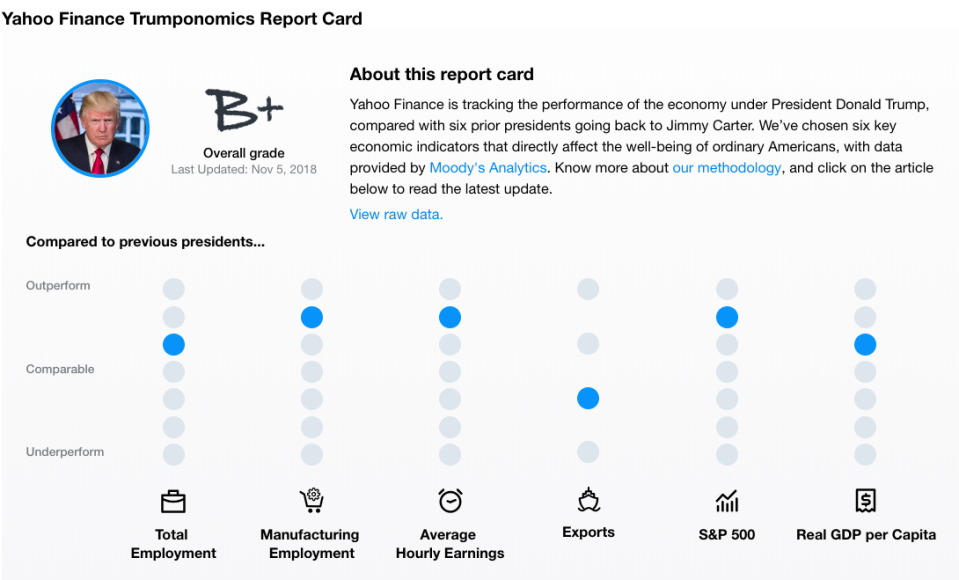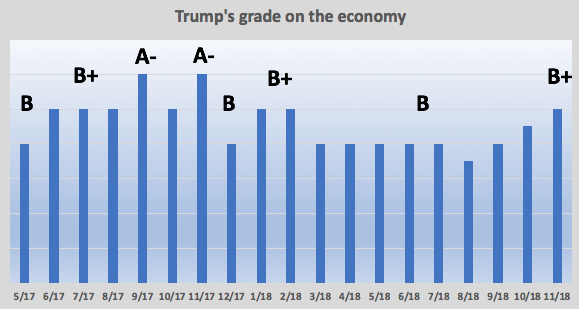Trump’s grade on the economy rises just before the midterms
After hovering for eight months at a B grade on the Yahoo Finance Trumponomics Report Card, President Trump has drifted up to B+. This occurs, of course, right before voters render judgment on his performance after nearly two years in the White House.
Trump’s grade rose one notch in our monthly assessment, largely because workers’ earnings improved in the latest set of data. Our Trumponomics Report Card analyzes six economic indicators, using data provided by Moody’s Analytics. We compare the economy under Trump to the economy under seven prior presidents going back to Richard Nixon in the 1970s, at the same point in their terms. (Check out our full methodology.)
Here’s the last report card prior to the midterm elections:

Americans are predictably split on whether Trump deserves credit for the performance of the economy during his time in office. Trump supporters say the GOP tax cuts and deregulatory push have stimulated spending and hiring. Others point out that many of the current trends were in place during President Obama’s second term, and have merely continued. In general, assigning credit (or blame) for the path of the economy is inadvisable, since many factors drive the economy over long periods of time. Suffice to say the president tends to get credit or blame for the performance of the economy, whether deserved, or not.
[See how the midterms will affect your money.]
Trump has gotten strong marks so far for total employment, manufacturing employment, and stock-market returns. With the latest set of data, he rose from third-best on average hourly earnings to second best, surpassing President Barack Obama. Earnings growth was still stronger at this point in George W. Bush’s term.
Trump is third-best on total employment, which was better under Bill Clinton and Jimmy Carter at the 21-month point of their presidencies. Trump is second best on manufacturing employment, which was better under Carter. Stocks have done well under Trump, giving him the second-best performance, after Obama, who came into office just as a stock-market crash was about to bottom out.
Trump’s weakest spot is exports, where he ranks second out of four. (That data only goes back to 1993, which limits our comparison to three predecessors rather than seven.) On overall GDP growth, he ranks third out of seven presidents. While growth has been relatively strong this year, it was better under Bill Clinton and Jimmy Carter. Here’s how Trump’s grade has fluctuated since we launched the report card in May, 2017:

For Trump’s grade to improve one step further, to A-, he’d have to move up a notch in at least two different categories. A combo of higher earnings and stronger GDP growth would be the most likely way to get there. Trump might be more likely to backslide, however. There’s evidence economic growth is slowing rather than accelerating, and those worries have contributed to the recent stock selloff. Some economists think a slowdown is inevitable and a recession possible within a couple of years.
It’s also not clear midterm voters will reward Trump and his fellow Republicans for the strong economy. The Trump tax cuts are unpopular, with many Americans feeling they favored businesses and the wealthy over middle-class families. Some voters say health care and immigration and more important issues than the economy. And Trump has riled some farmers and manufactures with protectionist trade policies that have left them vulnerable to retaliation from other countries, especially China.
Trump’s approval rating, around 44%, is very low for a president who can brag about a 3.7% unemployment rate. So Trump probably scores lower on other issues than he does on the economy. Voters are about to spell out exactly how.
Confidential tip line: [email protected]. Click here to get Rick’s stories by email.
Read more:
Rick Newman is the author of four books, including “Rebou
